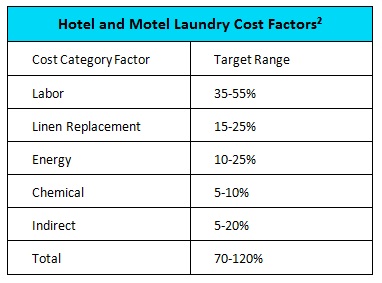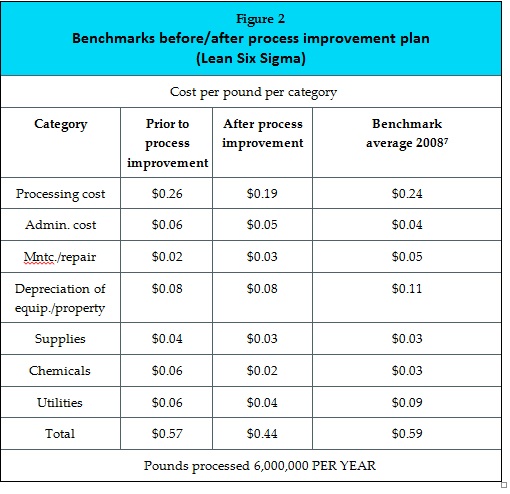by Cliff Beiser — Originally published in the June/July 2019 issue of ISSA
You are tasked to “benchmark” your laundry operations and make them more efficient and profitable. You are not allowed to spend a bunch of money to buy the needed numbers and math was not your “best” subject.
This article is for anyone who:
- Needs to improve their operation, or
- Needs some solid data to compare your operation against.
 First, let’s look at a big picture overview of the U.S. linen industry. According to Hoovers,¹ the U.S. linen and uniform supply services industry includes about 1,400 companies with a combined annual revenue of more than $9 billion. The industry is concentrated with the 50 largest companies accounting for about 75 percent of revenue.¹ This first chart presents a benchmark range of the major cost elements in a laundry operation.
First, let’s look at a big picture overview of the U.S. linen industry. According to Hoovers,¹ the U.S. linen and uniform supply services industry includes about 1,400 companies with a combined annual revenue of more than $9 billion. The industry is concentrated with the 50 largest companies accounting for about 75 percent of revenue.¹ This first chart presents a benchmark range of the major cost elements in a laundry operation.
When you see charts of this type, the question that occurs to many is: Why such large ranges? The answer given most often is: It depends. Based on over 20 years of experience of managing laundries, from the very small to over 6,000,000 pounds per year, I have finally decided that the correct response to “it depends,” is to measure how you are doing today, using key performance indicators (KPIs), such as those in the following table , and improve the operation with your entire team participating.
Benchmark KPIs:
Safety
- Loss time from accidents: 110 days reduced to 6 days
Production
- Pounds per operator hour: 42 pounds per hour increased to 57 pounds per hour
Quality
- Percent of rewash and rejects: Five percent reduced to one percent
Equipment/maintenance
- Repair costs
- Percent of unplanned to planned maintenance: Reduced from 19 to four percent
- Percent of delay: Not tracked in previous year
- Percent of PM completion: Increased from zero percent to 100 percent
Management
- Pounds: Increased by 400,000 pounds
- Cost per pound: Reduced from $.40 to $.36 per pound.
After reviewing consulting assignments performed by experts such as Braun, as well as Peril & Alexander, LLC, and the publications listed at the conclusion of this article, there are certain standards, goals, and tools used to change your laundry from a continuous nightmare, to a place of teamwork and success!
The Laundry, which we will use as a model, had just lost $150,000. To make matters worse, the linen and terry sat outside for at least three days in the weather due to the growth of the property, but not a concurrent growth in the laundry plant. The size of the ideal laundry production area of the building can be determined by multiplying the pounds per hour times 6.5 square foot of space. The size of the building will depend on the number of hours that the laundry is to operate during the high occupancy season.
Since the company made it clear that enlarging the building in the short term was not an option, it was decided that an in-depth study of current processes and laundry machinery would be completed immediately, while a leading consulting company would be hired for planning the future laundry building. In addition, it was decided to build a KPI chart and track the metrics every year to build consistency of performance. The KPI’s chosen benchmarks, as well as the results (italics) are in the table above. Next, an engineer was brought in to build an encompassing maintenance program. Lastly, Lean Six Sigma tools were used to identify “Time Traps and Capacity Constraints” to eliminate the linen and terry being out in the weather as much as possible to save both labor dollars, but more importantly the real dollar loss of rotting linen and terry.
Let’s start with the most powerful process improvement: Finding the time traps that lead to reduced productivity and capacity underutilization. The chart below illustrates visually what was discovered.
The power behind this chart is that 10 minutes per load of lead time or found time. Lead time is how long it takes you to deliver your service once it is required. Lead time = amount of work-in-process/average completion rate. This equation tells us how long it will take any item of work to be completed (lead time) simply by counting how much work is sitting around (laundry in this case) waiting to be completed (things-in-process) and how many towels, sheets, etc. we can complete each hour, day, week, etc. (average completion rate).³
Loads processed per year were over 100,000 x 10 minutes per load = 1,000,000 minutes of non-productivity. This does not include the discovery that the dry time was set five minutes too long and caused a loss of production at both the terry folder and the ironer. The positive financial results of this Lean Six Sigma tool can be seen in the chart at the conclusion of the article.
Benchmarking also includes the machinery itself (washers and dryers). The importance of preventive maintenance cannot be overstated, as can be seen in the following excerpt from a leading laundry publication:
Maintenance considerations:⁴
Reactive maintenance: Breakdown or emergency correction. Immediate problem with quality, production, or stoppage.
Preventive maintenance: Time based, scheduled tasks (daily, monthly, quarterly, or annually) to prevent reactive maintenance.
Predictive maintenance: Performs needed maintenance based on the condition of the equipment and process.
The return on investment in savings and increased reliability from a proactive rather than reactive maintenance approach, has been proven time and time again. This type of program will keep your equipment running efficiently, and thereby reduce unnecessary utilities and costs. The time and money spent on preventive maintenance is a key indicator of “pay now or pay later”. Maintenance is a perfect example to use to show working operational hours improvement to upper management. On the KPI chart previous, the improvements in this aspect helped improve net income over $300,000 per year!
Now that our machines are working and at peak capacity due to our process improvement, it is very important that we use a proper wash formulation. The following benchmark information is reprinted from Executive Housekeeping Today:
There are four basic factors in any good wash formulation: Time, temperature, mechanical action, and chemistry.⁵
Time: Is the total contact time with chemical solutions, rinse, and flush steps.
Temperature: Ideal temperature range varies according to soil, fabric, chemistry, and energy saving requirements. Typically, 140ᵒ to 160ᵒ is best for suds and bleaching in medium to heavy soil classifications. 100ᵒ-120ᵒ is adequate for light soil classifications and with chemistry designed for low temperature washing. 80ᵒ-110ᵒ is used for flush and rinse steps. Chemical reactions are accelerated with higher temperatures, thus enhancing the cleaning operation.
Mechanical action: The dropping and pounding in the wash wheel. The degree of mechanical action is directly related to the loading and water levels of the wash wheel. Overloading reduces mechanical action. Mechanical action is optimized at water levels between five to seven inches. For a gentler wash, raise the water level.
Chemistry: Refers to the interaction of soils and fabrics with the various types and concentrations of chemicals used in the wash wheel. Your chemical supply company should be able to help determine the best chemistry combination for your operation.
Dryer performance statistics:⁶
- Production = pounds of H2O removed per minute
- Efficiency = BTU’s used per pound of H2O removed
- Drying time should be less than 35 minutes for a load of towels.
- Laundry experts state 90 percent of on-premise-laundries over dry an average of six minutes.
- Savings of one hour per day if corrected.
 The second piece of advice is to keep it fun, as found in the following: “In experiment after experiment, the workers who think they are doing better, did better. In one experiment, ten people were given puzzles to solve. They were all given fictitious results. Half were told they had done well; the other half were told they had done poorly. They were then given a second test and this time they all did as well or as poorly as they were told they did on the first test.”⁸ Every team and each person on the team must maintain their confidence and use every resource available (benchmarking) to improve their laundry.
The second piece of advice is to keep it fun, as found in the following: “In experiment after experiment, the workers who think they are doing better, did better. In one experiment, ten people were given puzzles to solve. They were all given fictitious results. Half were told they had done well; the other half were told they had done poorly. They were then given a second test and this time they all did as well or as poorly as they were told they did on the first test.”⁸ Every team and each person on the team must maintain their confidence and use every resource available (benchmarking) to improve their laundry.
- Processing cost = Direct labor costs including fringe benefits that are applicable to sorting, washing, drying, ironing, moving, and preparing linen and terry for delivery.
- Administration cost = Management, secretarial, contracting administration, general foreman, and any non-production employees.
- Maintenance/repair cost = Processing and other support equipment, carts, etc., labor cost and materials associated with routine maintenance of laundry equipment.
- Depreciation of equipment = Equipment value divided by 15 years.
- Depreciation of property = Land and building, combined with applicable property taxes divided by 75 years.
- Supplies = Leasing of office equipment, office supplies, etc.
- Chemicals = Laundry chemicals, water treatment, etc.
- Utilities = Electrical, steam, gas, water, oil, sewage, garbage removal, etc.
Endnotes
²Hotel and Motel Laundry Cost Factors: Rich Fitzmorris written 2003
³Lean Six Sigma for Service: Michael L. George
⁴Laundry Today: Preventive Maintenance—Pay Now or Pay Later
⁵Executive Housekeeping Today; June 2003 (no longer published)
⁶Laundry Today: Dryers—A Fundamental Part of a Laundry
⁷Textile Care Processing Cost Benchmarks; Ken Tyler
⁸Warren Bennis: Speaker’s Library of Business Stories, Anecdotes, and Humor; Joe Griffith
About the author
 Cliff Beiser is a CIMS Assessor with a Black Belt Lean Six Sigma and a Green Belt in Six Sigma. Beiser has comprehensive experience using Lean Tools and Integrated Cleaning Measurement (ICM). He can be reached at cliff.beiser@championstouch.com.
Cliff Beiser is a CIMS Assessor with a Black Belt Lean Six Sigma and a Green Belt in Six Sigma. Beiser has comprehensive experience using Lean Tools and Integrated Cleaning Measurement (ICM). He can be reached at cliff.beiser@championstouch.com.
